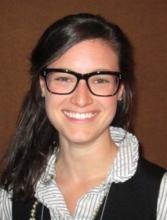SAN DIEGO – Inconsistent diagnostic and treatment practices for the diagnosis of adolescent polycystic ovary syndrome exist among clinicians in adolescent medicine, gynecology, and endocrinology, results from a single-center, retrospective study demonstrated.
The differences "could reflect provider comfort within their specialty and how their specialty approaches these symptoms," Sarah Powers said at the annual meeting of the North American Society for Pediatric and Adolescent Gynecology.
Many criteria exist for the diagnosis of polycystic ovary syndrome (PCOS), said Ms. Powers of Georgetown University in Washington. The National Institutes of Health criteria from 1990 state that, to make the diagnosis, menstrual irregularity and androgen excess must be present, as well as no other possible etiologies for the diagnosis. According to the Rotterdam criteria from 2003, patients must have two of three factors to meet the diagnosis: menstrual irregularity, evidence of androgen excess based on clinical or laboratory data, and polycystic ovaries on ultrasound. Meanwhile, the Androgen Excess and PCOS Society guideline from 2006 requires evidence of androgen excess and either menstrual irregularity or polycystic ovaries.
"Adolescents are an interesting subset of PCOS patients," Ms. Powers said. "In the first place, they are difficult to diagnose. Many signs of PCOS are physiologically common within the adolescent population, including menstrual irregularity, acne, and polycystic ovaries. Secondly, does the diagnosis even need to be made in teenagers? How long should we wait after menarche to make the diagnosis? If PCOS is diagnosed and treated early, does this make a difference for the patient?"
In addition, she continued, adolescents with PCOS "can present to a number of specialties, including adolescent medicine, gynecology, and endocrinology." In an effort to assess how these pediatric subspecialties would work up, diagnose, and treat patients with PCOS, Ms. Powers and her associates conducted a retrospective chart study of 261 postmenarchal females aged 11-18 years from Children’s National Medical Center who had been worked up for or diagnosed with PCOS between June 2009 and October 2011. They excluded patients with a coexisting diagnosis of other primary etiology for amenorrhea.
Of the 261 patients, 144 (55%) were seen by endocrinologists, 9 (3.5%) by gynecologists, and 108 (41.5%) by adolescent medicine specialists. The mean age of patients at the time of their initial work-up was 15 years. There were no significant differences between the three patient populations in age, age at first menses, body mass index, obesity rates, or type of insurance. However, a higher percentage of African American patients were seen by adolescent medicine specialists, compared with clinicians in the other specialties.
Ms. Powers reported that 49% of adolescent medicine specialists ordered lipid tests, compared with 22% of gynecologists and 16% of endocrinologists, a difference that reached statistical significance (P less than .0001). Meanwhile, 44% of gynecologists ordered fasting glucose measures, compared with 38% of adolescent medicine specialists and 22% of endocrinologists, a difference that was also statistically significant (P less than.05). The proportion of HbA1c and fasting insulin measures ordered were similar among all three groups.
A significantly greater proportion of adolescent medicine specialists (31%; P less than.05) ordered total T4 labs compared with their counterparts, while rates of ordering androgen labs were about the same in all three specialties. "More than 80% of patients worked up for PCOS had a total testosterone test ordered for them," Ms. Powers said. "Ordering measurements of the other sex hormones was much less consistent. Endocrinologists were more likely to order estradiol while adolescent medicine specialists ordered more prolactin, and gynecologists ordered more 17-hydroxyprogesterone."
In addition, the majority of gynecologists (89%) ordered pelvic ultrasounds, compared with 9% of adolescent medicine specialists and 24% of endocrinologists.
Of all the 261 patients who were worked up for PCOS, 187 (72%) had at least two of the Rotterdam criteria. "Only hirsutism was used as evidence of clinical hyperandrogenism," Ms. Powers said. "Acne was not used as a marker." Of these patients, 33% were diagnosed with PCOS and 38% were diagnosed with likely PCOS. "Some caveat was given: either likely PCOS, possible PCOS, or probable PCOS – some variation on that," she said. Upon chart review, irregular menses and clinical and biochemical evidence of hyperandrogenism were used most often as justification for a PCOS diagnosis.
As for the treatment of patients who met diagnostic criteria for PCOS, metformin was prescribed most often by endocrinologists (58%), compared with 30% of adolescent medicine specialists and 14% of gynecologists. At the same time, oral contraceptives were prescribed most often by adolescent medicine specialists (58%), compared with 43% of gynecologists and 24% of endocrinologists.


